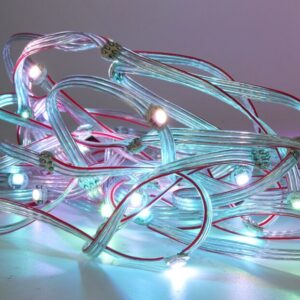Conductive fabrics have many uses, and through creative projects we can explore many different types of circuits. Conductive fabrics, materials, and cloth are great for wearable projects, and your electronics hobby.
Let’s jump in with a few descriptions of conductive fabrics!
Conductive fabrics are materials that have been made, usually, with more than one material. Typically, they are made from, or are coated or blended with some conductive metals. A non-conductive fabric is used as a base. This can be a variety of metals, including gold, carbon, titanium, nickel, silver, or copper. this is usually mixed with or woven with a base fabric material. The base is often cotton, wool, polyester, or nylon.
This is done using coating processes such as: spraying, electroless plating, sputter coating, plasma treatment, vacuum metallization, in situ polymerization, chemical vapour deposition, textile coating/printing etc.
The less fabric that is blended or woven with the metal, typically the firmer it is. We have some copper fabric, for example, that is all copper strands, and this is a firm fabric to use. It looks stunning with the copper sheen colour!

There is a variety of types of conductive fabrics, some are very soft and lush, like in the above video. Others are a lot more firm and less pliable. However, it depends on your project to decide what fabric to use. If you’re not bending or sculpting around the body, but are laying it flat, for example, then this may not matter as much.
The fabric itself can be used as a ‘switch’ in an electronic circuit to perform a function. In order for a ‘switch’ to happen, a connection between two conductive fabrics or yarns needs to occur. but this can also be between conductive fabric and other conductive items. I’ve used metal charms or clasps too.
Mix it up – try our top choices
Try different conductive fabrics to learn about their unique properties. Find the one that suits your project. You might prefer one that is sewable, and that you add iron-on adhesive, or you might just want to glue a solid fabric in place.




Don’t forget you might also see them described as conductive fabrics, conductive cloth, conductive yarns, conductive textiles, e-textiles or electronic textiles and so on.
A research paper describing conductive fabrics: https://www.sciencedirect.com/topics/engineering/conductive-fabric
Also, Knitted electronic textiles is a recent paper: https://www.sciencedirect.com/science/article/pii/B9780128192467000085
Time to get making
Now it’s your turn. Choose some of these unique fabrics to start your own projects, or follow along as you’re learning with some of my tutorials. Please leave a comment or question below.


